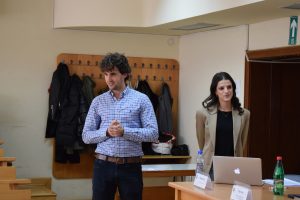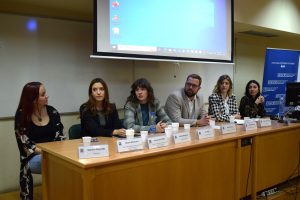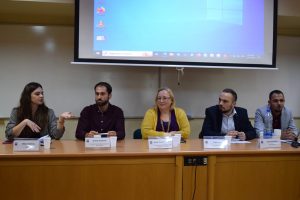The project “Paint for Peace: Engaging Students in Youth, Peace, and Security,” conceived and organized by students of the MA in Peace, Security, and Development as part of the Joint Project course, was successfully implemented at the Faculty of Political Sciences, University of Belgrade.
The first part of the project included the conference “Youth, Peace, and Security,” addressing topics such as gender equality, gender-based violence, and the current issue of armed violence. In addition to the experts and MA students, who shared their knowledge and experince in reseraching and dealing with different topics relevant to YPS agenda, valuable contribution was given by the undergraduate students of the Faculty of Political Science who presentated their policy papers and recommendations on how these issues can be tackled.




Augusta Fetherstone, speaking on behalf of the Organization for Security and Cooperation in Europe (OSCE) Mission to Serbia, highlighted the pleasure of working with youth, not only in Serbia but also in the other 56 countries involved in OSCE missions. Ivana Markulić, on behalf of the Regional Youth Cooperation Office (RYCO), emphasized the importance of the Faculty of Political Sciences as an institution where scientific research and academic discussions on these topics take place. Prof. Dr Natalija Perišić, the Vice-Dean for Undergraduate Studies at the Faculty of Political Sciences, pointed out that the strongest asset of the Faculty is its students, who enjoy an interdisciplinary approach and the opportunity to view the broader aspects of the topics studied. Professor Filip Ejdus, one of the coordinators of the MA in Peace, Security, and Development and the mentor of this project, gave more details on how students created, conceived, and implemented the mural painting and the organization of the conference as part of the “Joint Project” course.


After the introductory part of the conference, the mural Ramonda serbica by the author Andrej Žikić Artez was unveiled on the building of the Faculty of Political Sciences. Ramonda serbica, also known as the “Serbian Phoenix Flower,” is a rare and resilient plant endemic to the Balkans. It is known for its resistance to drought and its ability to miraculously revive upon contact with water. This perennial plant, with rosette leaves and purple flowers, symbolizes resilience and rebirth, serving as a poignant reminder of nature’s resilience. It was discovered by Josif Pančić in 1874 on the slopes of Mount Rtanj. A few years later, a very similar plant was found and named Ramonda Nathaliae after Queen Natalija Obrenović. Since 2012, it has been used in Serbia as a symbol of Armistice Day, a national holiday commemorating the end of World War I on November 11th. The author of the mural is Andrej Žikić Artez.
The project was funded by the Organization for Security and Cooperation in Europe (OSCE) Mission to Serbia, the Regional Youth Cooperation Office (RYCO), and the Federal Foreign Office. The project was supported by the company Tenge DOO.







